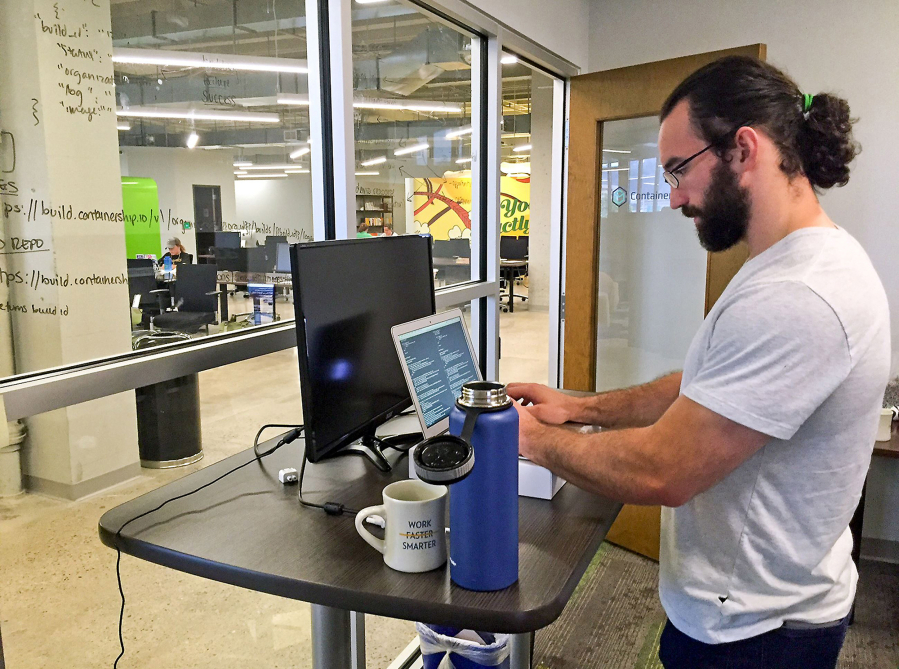PITTSBURGH — You may want to stand up while you read this: Studies show Americans sit on average between eight and 12 hours a day. Many sit in the car on the way to work. We sit in our chairs at our desks. We sit down to eat lunch. We sit through office meetings. Then we sit during our evening commute. At the end of the day, we sit while eating dinner, watching TV and surfing the web.
Even for those who exercise an hour or two every day, prolonged sitting has been associated with heart disease, low metabolism and something that researchers are calling “dormant butt syndrome,” a tightness of the hip flexors and weakness of the gluteal muscles.
Chris Kolba, a physical therapist at Ohio State University, coined the term for a condition that can be a result of sitting throughout the day. A May study published by Ohio State’s Wexner Medical Center found DBS may be the cause of knee, back and hip pain.
Yet many of us sit, sit and sit.
“We were put on this earth to be hunters and gatherers,” said Ron DeAngelo, director of sports performance training at the University of Pittsburgh Medical Center Rooney Sports Complex in Pittsburgh. “But now we’re hunters and gatherers of information on a computer.”
When DeAngelo first meets with patients, he’ll often ask them what they do for a living and how much they sit. “If your butt is not in the game” and you’re sitting down, he said, other parts of your body have to work harder, which can lead to injury.
While standing desks are nothing new — Charles Dickens, Thomas Jefferson and Donald Rumsfield used them — they have gained popularity over the past decade. A few years ago, some considered standing desks weird. Now they are almost commonplace.
A 20-year history of studies show people who work at standing desk stations are about 10 percent more productive than those who sit.
For one year, Texas A&M researchers followed high school students who were given standing desks at their school and found an increase of about 10 percent in students’ cognitive improvement.
Transition pains
Using a standing desk is one of the easiest ways to train yourself to stand more. They range from about $150 to $450 and can be picked up at major retailers such as Target, Office Depot and Bed Bath & Beyond. Alternatively, you can also move your desk to a hightop table or create a makeshift standing desk by stacking books underneath the computer, as ContainerShip senior software engineer Nick Tate did a few years ago.
Now he has a more traditional standing desk that can be adjusted to accommodate users of various heights.
It was not a particularly quick migration from traditional office desk and chair to standing desk for either Tate or Frank Dawson, an associate vice president at the global architectural firm CannonDesign, which has a location in downtown Pittsburgh. Both found growing pains come with a new standing desk, most notably that it takes about two weeks to get used to one.
“You have to sort of work yourself into it,” said Dawson, 48. “It’s not like, ‘Oh, yeah, this is the greatest thing ever,’ but after you do it, it’s not so bad.
“(At first) it can hurt your legs and you can almost feel like an assembly line worker,” he added. “You feel it in the feet.”
Other side effects
Dawson has used a standing desk for about four years. He has a “legit” back problem: a deteriorating disc, also called degenerative disc disease. For Dawson, it causes lower back pain.
Standing at work and stretching daily alleviates the pain.
“When I sit — if I sit all day — I’m in misery by the end of the day,” he said. “You get tired. You don’t want to do anything.”
The standing desk is still a novelty in the office, so Dawson’s co-workers come up to him with questions. “Do you like it or do you not like it?” he’ll get asked.
That’s how Dawson got the inclination to get one for himself. Somebody else in the office had one, he inquired about it, and soon he latched one onto his desk. One side effect, in his view, is a more collaborative workplace.
“It’s much easier to have somebody come over here and stand (beside the desk) and we can talk about a project together standing,” he said. “We don’t have to pull up a chair and bend over to look at a design.”



